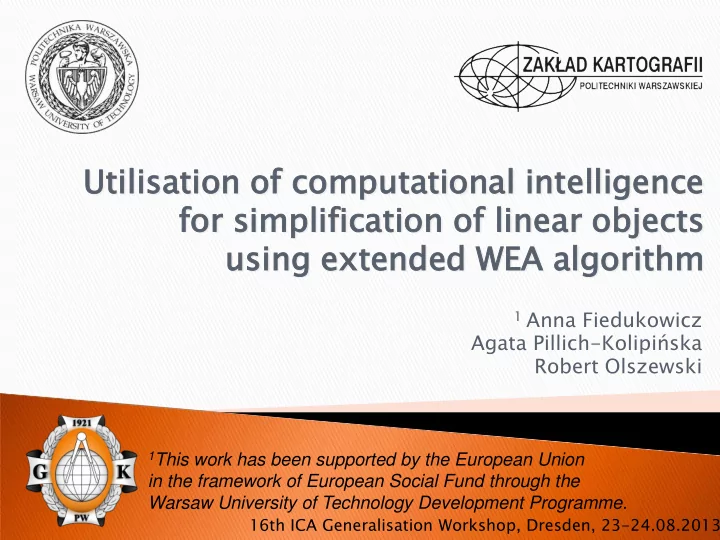

Utilisation of computational intelligence for simplification of linear objects using extended WEA algorithm 1 Anna Fiedukowicz Agata Pillich- Kolipińska Robert Olszewski 1 This work has been supported by the European Union in the framework of European Social Fund through the Warsaw University of Technology Development Programme. 16th ICA Generalisation Workshop, Dresden, 23 - 24.08.2013
Widely known and described Selection of „important” vertices Different algorithms, mostly on one- parameter ones ◦ Douglas - Peucker (1973) - distance ◦ Visvalingam - Whyatt (1993) – „effective area” ◦ Wang (1996) – curve radius ◦ many others… 2
„Shape - aware” algorithm S. Zhou, C.B. Jones (2004) – 4 parameters : ◦ „effective area” from Visvalingam - Whyatt algorithm ◦ flatness (H/W) ◦ skewness (H/ML) ◦ convexity (↻ – convex, ↺ – concave) Defined filters: ◦ W flat ◦ W skew ◦ W convex WEA = W flat * W skew * W convex * EA 3
Non- deterministic approach: knowledge base Vertex weight = f ( flatness, skewness, convexity, EA) Explicit Implicit set of rules derived from examples defined by an expert provided by an expert computational intelligence Fuzzy Inference Artificial Neural Systems Networks Modified „WEA” (weight of a vertex) 4
Vertex weight = f ( flatness, skewness, convexity, EA) rules examples Defined by an expert, eg. Important points derived from Topographic DBs and if (EA > 100) and (flatness maps 1:10k, 1:50k, 1:250k > 1) and (skewness > 0.8 ) then weight = 99; Polish coastline (SABE 30 and surveying data) Or more fuzzy definition: Polish rivers if EA is big and flatness is high and skewness is low Vertices weights proposed then vertex is important by an expert 5
STATISTICA Neural Networks software INPUT OUTPUT TEACHING VALIDATION 6
Three types of ANNs tested Different teaching algorithms tested (backward errors propagation, quasi - Newton, Delta - Bar - Delta, Levenberg - Marquardt etc.) 7
Testing different structures of same ANN type More neurons ⇒ higher precision ⇒ output less generalized ⇒ learning more time - consuming ⇒ longer data processing Test data – several neurons Actual data – several thousands neurons? 8
9
• IF building<400m 2 THEN y=0,05 A B • IF building is small THEN simplify a bit How you define „small”? 10
1 0.7 BIG 0.3 SMALL 0 11
• IF x = A THEN y = B A B • IF x = A THEN y = B •And what IF x = A’ ? THEN y = B’ 12
IF area =„big” and flatness=„big” then significance =„big” 14
15
Easy to build Difficult to define Allows process Black box for user understanding Long computation time Builded once for complex tasks works fast NEURO FUZZY 16
Tools independent Combine fuzzy and on GIS neuro tools with GIS sofware Check tools on Preliminary tests different type of data on polish coast line Up to now Future plans 17
Here it comes, here comes the weekend… r.olszewski@gik.pw.edu.pl a.pillich@gik.pw.edu.pl a.fiedukowicz@gik.pw.edu.pl
Recommend
More recommend